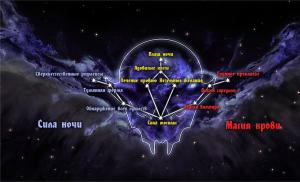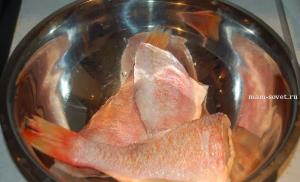Resolution and magnification of the microscope. Microscope resolution and magnification What determines the resolution of a microscope
The microscope is designed to observe small objects with high magnification and with a higher resolution than a magnifying glass gives. The optical system of a microscope consists of two parts: an objective and an eyepiece. The microscope objective produces an actual magnified reverse image of the object in the anterior focal plane of the eyepiece. The eyepiece acts like a magnifying glass and creates a ghost image at the best viewing distance. In relation to the entire microscope, the object under consideration is located in the anterior focal plane.
Microscope magnification
The action of a microlens is characterized by its linear magnification: V about = -Δ / F \ "about * F \" about - the focal length of the micro lens * Δ - the distance between the rear focus of the lens and the front focus of the eyepiece, called the optical interval or optical length of the tube.
The image created by the microscope objective at the front focal plane of the eyepiece is viewed through the eyepiece, which acts like a magnifying glass with visible magnification:
G ok = ¼ F ok
The total magnification of the microscope is defined as the product of the objective magnification and the eyepiece magnification: G = V rev * G approx
If the focal length of the entire microscope is known, then its apparent magnification can be determined in the same way as for a magnifying glass:
As a rule, the magnification of modern microscope objectives is standardized and amounts to a number of numbers: 10, 20, 40, 60, 90, 100 times. Eyepiece magnifications also have quite definite values, for example 10, 20, 30 times. All modern microscopes have a set of objectives and eyepieces that are specially designed and manufactured so that they fit together, so they can be combined to obtain different magnifications.
Microscope field of view
The field of view of the microscope depends on the angular field of the eyepiece ω , within which an image of sufficiently good quality is obtained: 2y = 500 * tg (ω) / G * G - microscope magnification
With a given angular field of the eyepiece, the linear field of the microscope in the space of objects is the smaller, the greater its apparent magnification.
Microscope exit pupil diameter
The exit pupil diameter of the microscope is calculated as follows:
where A is the front aperture of the microscope.
The diameter of the exit pupil of the microscope is usually slightly smaller than the diameter of the pupil of the eye (0.5 - 1 mm).
When viewed through a microscope, the pupil of the eye must be aligned with the exit pupil of the microscope.
Microscope resolution
One of the most important characteristics of a microscope is its resolution. According to Abbe's diffraction theory, the linear limit of resolution of a microscope, that is, the minimum distance between points of an object that are displayed as separate, depends on the wavelength and numerical aperture of the microscope:
The maximum achievable resolution of an optical microscope can be calculated based on the expression for the microscope aperture. If we take into account that the maximum possible value of the sine of the angle is unit, then for the average wavelength it is possible to calculate the resolution of the microscope: ![]()
There are two ways to increase the resolution of the microscope: * By increasing the objective aperture, * By decreasing the wavelength of light.
Immersion
In order to increase the lens aperture, the space between the object under consideration and the lens is filled with the so-called immersion liquid - a transparent substance with a refractive index greater than one. Water, cedar oil, glycerin solution and other substances are used as such a liquid. The apertures of immersion objectives of high magnification reach a value, then the maximum achievable resolution of the immersion optical microscope will be. ![]()
Application of ultraviolet rays
To increase the resolution of the microscope, the second method uses ultraviolet rays, the wavelength of which is shorter than that of visible rays. In this case, special optics must be used that are transparent to ultraviolet light. Since the human eye does not perceive ultraviolet radiation, it is necessary either to resort to means that convert an invisible ultraviolet image into a visible one, or to photograph an image in ultraviolet rays. At a wavelength, the resolution of the microscope will be. ![]()
In addition to improving the resolution, there are other advantages to observing in ultraviolet light. Usually living objects are transparent in the visible spectral range, and therefore they are pre-colored before observation. But some objects (nucleic acids, proteins) have selective absorption in the ultraviolet region of the spectrum, due to which they can be "visible" in ultraviolet light without staining.
The resolution of a microscope is characterized by a value inverse to the linear resolution limit. According to the Abbe diffraction theory, the linear limit of resolution of the microscope, i.e., the minimum distance between the points of the object, which are depicted as separate, is determined by the formula
where is the linear resolution limit; the wavelength of the light in which the observation is carried out; A is the numerical aperture, or simply the aperture, of the microscope (microlens).
From formula (324) it follows that to increase the resolution of the microscope, it is necessary to decrease the wavelength of light and increase the numerical aperture of the microscope. The first possibility is realized by photographing the objects under investigation in ultraviolet radiation.
The microscope aperture is determined by the formula where The value of the aperture angle of modern high-quality micro-lenses has been brought almost to the limit.
Another possibility of increasing the aperture is the use of an immersion liquid placed between the object under consideration and the microlens. As such a liquid, water is used cedar oil monobromonaphthalene
![]()
In order for the observer's eye to fully utilize the resolution of the microscope, determined by formula (324), it is necessary to have a corresponding apparent magnification. If two points of the front focal plane of the optical system are located from each other at a linear distance (Fig. 157), then

Rice. 157. Scheme for determining the useful magnification of the microscope
the angular distance between these points in image space
The observer's eye will perceive these points as separate if the angular distance between them is not less than the angular limit of the eye's resolution
![]()
From formulas (325), (324) and (317) it follows that the apparent magnification of the microscope
![]()
The last formula can be used to determine the minimum apparent magnification at which the observer's eye will fully utilize the resolution of the microscope. This increase is called beneficial. When using formula (326), it should be borne in mind that in many cases the diameter of the exit pupil of the microscope is.This leads to an increase in the angular limit of the resolution of the eye to we get the magnification of the microscope.
Elena 3013
This article will talk about the magnification of the microscope, the units of measurement of this value, the methods of visually determining the resolution power of the device. We will also talk about the standard settings for this value and how to calculate the magnification for a particular type of work.
Most often, the main parameters of the microscope power are indicated on the objective body. Unscrew the lens and inspect it. You can see two numbers written with a fraction. The first is magnification, the second is the numerical aperture.
The aperture characterizes the ability of the device to collect light and obtain a clear image. Also, the length of the tube and the thickness of the cover glass required for work can be indicated on the objective.
All About Microscope Magnification
 Magnification is measured in krat (x). The relationship of the eyepiece-objective system completely determines its meaning. The product of the eyepiece and objective magnification tells us about the working magnification that this microscope creates. The dependence of the overall magnification on the lens magnification is obvious. By power, lenses are divided into the following groups:
Magnification is measured in krat (x). The relationship of the eyepiece-objective system completely determines its meaning. The product of the eyepiece and objective magnification tells us about the working magnification that this microscope creates. The dependence of the overall magnification on the lens magnification is obvious. By power, lenses are divided into the following groups:
Small (no more than 10x);
Medium (up to 50x);
Large (over 50x);
Extra large (over 100x).
The maximum magnification of the objective for an optical microscope is 2000x. The eyepiece value is usually 10x and rarely changes. But the lens magnification varies widely (from 4 to 100x and 2000x).
When choosing a microscope, you need to consider who will be working on it, and what maximum magnification may be needed. For example, 200x is enough for a preschooler, school and university microscopes have a magnification of 400-1000x. But the research device should give at least 1500-2000x. This value allows you to work with bacteria and small cell structures.
 |
|||
 |
|||
 |
|||
 |
Oksar.ru-Moscow | 900 RUB | |
 |
|||
 |
|||
| More suggestions | |||
Resolution of the device
 What determines the clarity and quality of the image that the microscope gives? This is influenced by the resolution of the device. To calculate this value, you need to find the quotient of the light wavelength and two numerical apertures. Consequently, it is determined by the condenser and the microscope objective. As a reminder, the numerical aperture value can be seen on the lens barrel. The higher it is, the better the resolution of the device.
What determines the clarity and quality of the image that the microscope gives? This is influenced by the resolution of the device. To calculate this value, you need to find the quotient of the light wavelength and two numerical apertures. Consequently, it is determined by the condenser and the microscope objective. As a reminder, the numerical aperture value can be seen on the lens barrel. The higher it is, the better the resolution of the device.
The optical microscope has a resolution limit of 0.2 microns. This is the minimum distance to the image when all points of the object are visible.
Useful microscope magnification
We talk about useful magnification when the investigator's eye makes full use of the resolution of the microscope. This is achieved by observing the object at the maximum permissible angle. The useful magnification depends only on the numerical aperture and the type of lens. When calculating it, the numerical aperture increases by a factor of 500-1000.
A dry lens (there is only air between the object and the lens) creates a useful magnification of 1000x, i.e. the numerical aperture is 1.
An immersion lens (between the object and the lens is a layer of immersion medium) creates a useful magnification of 1250x, i.e. the numerical aperture is 1.25.
A blurry or unclear image indicates that the useful magnification is greater or less than the above values. Increasing or decreasing the setpoint significantly degrades the performance of the microscope.
In this article, we talked about the main characteristics of an optical microscope and how to calculate them. We hope this information will be useful when working with this complex device.
tell friends
Light microscopy
Light microscopy provides an increase of up to 2-3 thousand times, a color and moving image of a living object, the possibility of microcinema and long-term observation of the same object, an assessment of its dynamics and chemistry.
The main characteristics of any microscope are resolution and contrast. Resolution is the minimum distance at which two points are displayed separately by the microscope. The human eye has a resolution of 0.2 mm for best vision.
Image contrast is the difference in brightness between the image and the background. If this difference is less than 3 - 4%, then it is impossible to catch it either with the eye or with a photographic plate; then the image will remain invisible, even if the microscope resolves its details. Contrast is influenced both by the properties of the object, which change the luminous flux compared to the background, and by the ability of the optics to pick up the resulting differences in the properties of the beam.
The capabilities of a light microscope are limited by the wave nature of light. The physical properties of light - color (wavelength), brightness (wave amplitude), phase, density and direction of wave propagation change depending on the properties of the object. These differences are used in modern microscopes to create contrast.
Microscope magnification is defined as the product of the objective magnification times the eyepiece magnification. Typical research microscopes have an eyepiece magnification of 10, and an objective magnification of 10, 45 and 100. Accordingly, the magnification of such a microscope ranges from 100 to 1000. Some of the microscopes have magnifications of up to 2000. An even higher magnification does not make sense, since this the resolution does not improve. On the contrary, the image quality deteriorates.
Numerical aperture is used to express the resolution of an optical system or the aperture of a lens. Lens Aperture - The intensity of light per unit area of the image is approximately equal to the square of NA. The NA is about 0.95 for a good lens. The microscope is usually sized to have a total magnification of about 1000 NA. If a liquid (oil or, more rarely, distilled water) is introduced between the objective and the sample, you will get an "immersion" objective with an NA value of up to 1.4, and with a corresponding improvement in resolution.
Light microscopy methods
Light microscopy methods (illumination and observation). Microscopy methods are selected (and provided constructively) depending on the nature and properties of the objects under study, since the latter, as noted above, affect the image contrast.
Brightfield method and its varieties
The bright field method in transmitted light is used to study transparent preparations with absorbing (light-absorbing) particles and parts included in them. This can be, for example, thin colored sections of animal and plant tissues, thin sections of minerals, etc. In the absence of a preparation, a beam of light from the condenser, passing through the objective, gives a uniformly illuminated field near the focal plane of the eyepiece. In the presence of an absorbing element in the preparation, the light incident on it is partially absorbed and partially scattered, which causes the appearance of the image. The method can also be used when observing non-absorbent objects, but only if they scatter the illuminating beam so strongly that a significant part of it does not fall into the lens.
The oblique lighting method is a variation on the previous method. The difference between them is that the light is directed to the object at a large angle to the direction of observation. Sometimes it helps to reveal the "relief" of the object due to the formation of shadows.
Reflected light brightfield is used to investigate opaque objects that reflect light, such as metal or ore sections. Illumination of the preparation (from an illuminator and a semitransparent mirror) is performed from above, through the lens, which simultaneously plays the role of a condenser. In the image created in the plane by the objective together with the tube lens, the structure of the preparation is visible due to the difference in the reflectivity of its elements; in the bright field, inhomogeneities are also distinguished, scattering the light incident on them.
The dark field method and its varieties
Dark-field microscopy is used to produce images of transparent, non-absorbent objects that cannot be seen with the brightfield technique. These are often biological objects. The light from the illuminator and the mirror is directed to the preparation by a special condenser - the so-called. dark field condenser. Upon leaving the condenser, the main part of the light rays, which did not change their direction when passing through the transparent preparation, forms a beam in the form of a hollow cone and does not fall into the lens (which is located inside this cone). The image in the microscope is formed with the help of only a small part of the rays scattered by microparticles of the preparation on the slide inside the cone and passed through the objective. Dark-field microscopy is based on the Tyndall effect, a well-known example of which is the detection of dust particles in air when illuminated with a narrow beam of sunlight. In the field of view, against a dark background, light images of the structural elements of the preparation, which differ from the environment in refractive index, are visible. For large particles, only light edges are visible, scattering light rays. Using this method, it is impossible to determine by the type of image whether particles are transparent or opaque, they have a higher or lower refractive index compared to the environment.
Conducting a dark field study
Slides should be no thicker than 1.1-1.2 mm, cover slides 0.17 mm, no scratches or dirt. When preparing the drug, the presence of bubbles and large particles should be avoided (these defects will be visible brightly glowing and will not allow observing the drug). For dark-field, more powerful illuminators and the maximum incandescence of the lamp are used.
Darkfield lighting setup is basically as follows:
Set the light over Koehler;
Replace the bright-field condenser with a dark-field one;
Immersion oil or distilled water is applied to the upper lens of the condenser;
Raise the condenser until it touches the bottom surface of the slide;
A low magnification lens focuses on the specimen;
With the help of centering screws, a bright spot (sometimes having a darkened central area) is transferred to the center of the field of view;
Raising and lowering the condenser, they achieve the disappearance of the darkened central area and obtain an evenly illuminated bright spot.
If this is not possible, then it is necessary to check the thickness of the glass slide (usually this phenomenon is observed when using too thick glass slides - the cone of light is focused in the thickness of the glass).
After the correct setting of the light, the objective of the required magnification is installed and the preparation is examined.
The method of ultramicroscopy is based on the same principle - preparations in ultramicroscopes are illuminated perpendicular to the direction of observation. With this method, it is possible to detect (but not "observe" in the literal sense of the word) extremely small particles, the sizes of which lie far beyond the resolving power of the most powerful microscopes. With the help of immersion ultramicroscopes, it is possible to register the presence of particles in the preparation with particles up to 2 × 10 in -9 degrees m. But the shape and exact dimensions of such particles cannot be determined using this method. Their images are presented to the observer in the form of diffraction spots, the sizes of which do not depend on the size and shape of the particles themselves, but on the objective aperture and the magnification of the microscope. Since these particles scatter very little light, they require extremely strong light sources, such as a carbon arc, to illuminate them. Ultramicroscopes are mainly used in colloidal chemistry.
Phase contrast method
The phase contrast method and its variety - the so-called. method of "anoptral" contrast are intended for obtaining images of transparent and colorless objects, invisible when observed by the bright field method. These include, for example, live, unpainted animal tissue. The essence of the method is that even with very small differences in the refractive indices of different elements of the preparation, the light wave passing through them undergoes different changes in phase (acquires the so-called phase relief). Not perceived directly by either the eye or the photographic plate, these phase changes with the help of a special optical device are converted into changes in the amplitude of the light wave, that is, in changes in brightness ("amplitude relief"), which are already distinguishable by the eye or are fixed on the photosensitive layer. In other words, in the resulting visible image, the distribution of brightness (amplitudes) reproduces the phase relief. The resulting image is called phase contrast.
The phase contrast device can be installed on any light microscope and consists of:
A set of objectives with special phase plates;
Swing disc condenser. It has annular diaphragms corresponding to the phase plates in each of the objectives;
Auxiliary telescope for adjusting phase contrast.
Phase contrast adjustment is as follows:
Replace the objectives and the microscope condenser with phase objectives (designated by the letters Ph);
Install a low magnification lens. The hole in the condenser disc must be without an annular diaphragm (marked with the number "0");
Tune the light according to Koehler;
Choose a phase lens of appropriate magnification and focus it on the specimen;
Rotate the condenser disk and install the annular diaphragm corresponding to the lens;
2. The optical system of the microscope.
3. Magnification of the microscope.
4. Resolution limit. Resolution of the microscope.
5. Useful magnification of the microscope.
6. Special techniques of microscopy.
7. Basic concepts and formulas.
8. Tasks.
The ability of the eye to distinguish fine details of an object depends on the size of the image on the retina or on the angle of view. To increase the angle of view, special optical devices are used.
25.1. Magnifier
The simplest optical device for increasing the angle of view is a magnifying glass, which is a short-focus converging lens (f = 1-10 cm).
The object in question is placed between the magnifier and its front focus in such a way that its virtual image is within the range of accommodation for a given eye. Usually planes of far or near accommodation are used. The latter case is preferable, since the eye does not get tired (the annular muscle is not tense).
Let's compare the angles of view at which the object viewed "unarmed" is visible normal with the eye and with a magnifying glass. Let us perform the calculations for the case when a virtual image of an object is obtained at infinity (the far limit of accommodation).
When examining an object with the naked eye (Fig. 25.1, a), in order to obtain the maximum angle of view, the object must be placed at the best vision distance a 0. The angle of view at which the object is seen is β = B / a 0 (B is the size of the object).
When examining an object with a magnifying glass (Fig. 25.1, b), it is placed in the front focal plane of the magnifying glass. In this case, the eye sees a virtual image of an object B "located in an infinitely distant plane. The angle of view at which the image is visible is β" ≈ B / f.
Rice. 25.1. Angles of view: a- with the naked eye; b- using a magnifying glass: f - the focal length of the magnifying glass; N - the nodal point of the eye
Magnifying glass- angle of view ratioβ", under which you can see the image of an object in a magnifying glass, to the angle of viewβ, under which the object is visible to the "naked" normal eye from the distance of the best vision:
Magnifier magnifications are different for myopic and farsighted eyes, since they have different distances for the best vision.
Let us give, without derivation, the formula for the magnification given by a magnifying glass used by a myopic or far-sighted eye when forming an image in the plane of distant accommodation:
 where a distance is the far limit of accommodation.
where a distance is the far limit of accommodation.
Formula (25.1) allows us to assume that by decreasing the focal length of the magnifying glass, one can achieve an arbitrarily large magnification. In principle, this is so. However, when the focal length of the magnifying glass is reduced and its size is maintained, such aberrations arise that negate the entire effect of magnification. Therefore, single lens magnifiers usually have 5-7x magnification.
To reduce aberrations, complex magnifiers are made, consisting of two or three lenses. In this case, a magnification of 50 times can be achieved.
25.2. Microscope optical system
Greater magnification can be achieved by viewing with a magnifying glass the actual image of an object created by another lens or lens system. Such an optical device is realized in a microscope. The magnifying glass in this case is called eyepiece, and the other lens - lens. The path of the rays in the microscope is shown in Fig. 25.2.
Object B is placed close to the front focus of the objective (F rev) so that its actual, magnified image B "is between the eyepiece and its front focus.
 Rice. 25.2. Beam path in a microscope.
Rice. 25.2. Beam path in a microscope.
This gives the eyepiece a virtual magnified image B ", which the eye examines.
By changing the distance between the object and the lens, they achieve that the image B "is in the plane of the eye's distant accommodation (in this case, the eye does not get tired). For a person with normal vision, B" is located in the focal plane of the eyepiece, and B "is obtained at infinity.
25.3. Microscope magnification
The main characteristic of the microscope is its angular increase. This concept is analogous to the angular magnification of a magnifying glass.
Microscope magnification- angle of view ratioβ", under which you can see the image of the object in eyepiece, to the angle of viewβ, under which the object is visible to the "naked" eye from the distance of the best vision (a 0):
 25.4. Resolution limit. Microscope resolution
25.4. Resolution limit. Microscope resolution
One might get the impression that by increasing the optical length of the tube one can achieve an arbitrarily large magnification and, therefore, see the smallest details of the object.
However, taking into account the wave properties of light shows that restrictions are imposed on the size of small details distinguishable with a microscope. diffraction light passing through the lens opening. Due to diffraction, the image of the illuminated point turns out not to be a point, but small light circle. If the details (points) of the object under consideration are located far enough, then the lens will give their images in the form of two separate circles and they can be distinguished (Fig. 25.3, a). The smallest distance between distinguishable points corresponds to the "touch" of the circles (Fig. 25.3, b). If the points are very close, then the corresponding "circles" overlap and are perceived as one object (Fig. 25.3, c).
 Rice. 25.3. Resolution
Rice. 25.3. Resolution
The main characteristic showing the capabilities of the microscope in this regard is resolution limit.
Resolution limit microscope (Z) - the smallest distance between two points of an object, at which they are distinguishable as separate objects (i.e. perceived in a microscope as two points).
The inverse of the resolution limit is called resolution. The lower the resolution limit, the higher the resolution.
The theoretical resolution limit of a microscope depends on the wavelength of the light used for illumination and on angular aperture lens.
Angular aperture(u) - the angle between the extreme rays of the light beam entering the objective lens from the object.
 Let us indicate, without derivation, the formula for the resolution limit of a microscope in air:
Let us indicate, without derivation, the formula for the resolution limit of a microscope in air:
where λ - the wavelength of the light that illuminates the object.
Modern microscopes have an angular aperture of 140 °. If you accept λ = 0.555 μm, then we obtain the value Z = 0.3 μm for the resolution limit.
25.5. Useful microscope magnification
Let us find out how large the microscope magnification should be at a given resolution limit of its objective. Let's take into account that the eye has its own resolution limit due to the structure of the retina. In Lecture 24, we obtained the following estimate for eye resolution limit: Z GL = 145-290 microns. In order for the eye to be able to distinguish the same points that the microscope separates, an increase is required
This increase is called useful increase.
Note that when using a microscope to photograph an object in formula (25.4), instead of Z GL, the film resolution limit Z PL should be used.
Useful microscope magnification- magnification, at which an object having a size equal to the resolution limit of the microscope has an image, the size of which is equal to the resolution limit of the eye.
Using the above estimate for the microscope resolution limit Z m ≈0.3 μm), we find: Г п ~ 500-1000.
It makes no sense to achieve greater value for the magnification of the microscope, since no additional details can be seen anyway.
Useful microscope magnification - it is a clever combination of the resolution of both the microscope and the eye.
25.6. Special techniques of microscopy
Special microscopy techniques are used to increase the resolution (decrease the resolution limit) of the microscope.
1. Immersion. In some microscopes, to reduce resolution limit the space between the lens and the object is filled with a special liquid - immersion. Such a microscope is called immersion. The immersion effect is to reduce the wavelength: λ = λ 0 / n, where λ 0 - the wavelength of light in vacuum, and n is the refractive index of the immersion. In this case, the resolution limit of the microscope is determined by the following formula (generalization of formula (25.3)):
 Note that special objectives are created for immersion microscopes, since the focal length of the objective changes in a liquid medium.
Note that special objectives are created for immersion microscopes, since the focal length of the objective changes in a liquid medium.
2. UV microscopy. For decreasing resolution limit use shortwave ultraviolet radiation invisible to the eye. In ultraviolet microscopes, a micro-object is examined in UV rays (in this case, the lenses are made of quartz glass, and registration is carried out on photographic film or on a special luminescent screen).
3. Measuring the size of microscopic objects. Using a microscope, you can determine the size of the observed object. For this, an eyepiece micrometer is used. The simplest eyepiece micrometer is a round glass plate with a graduated scale. The micrometer is installed in the plane of the image obtained from the objective. When viewed through the eyepiece, the image of the object and the scales merge, you can count the distance along the scale corresponds to the measured value. The price of the division of the eyepiece micrometer is preliminarily determined by the known object.
4. Microprojection and microphotography. Using a microscope, you can not only observe an object through an eyepiece, but also photograph it or project it onto a screen. In this case, special eyepieces are used, which project the intermediate image A "B" onto a film or screen.
5. Ultramicroscopy. The microscope allows you to detect particles that are outside the range of its resolution. This method uses oblique lighting, due to which the microparticles are visible as light points against a dark background, while the structure of the particles cannot be seen, it is only possible to establish the fact of their presence.
The theory shows that, no matter how strong the microscope is, any object less than 3 microns in size will appear in it simply as one point, without any details. But this does not mean that such particles cannot be seen, tracked or counted.
To observe particles smaller than the resolution limit of the microscope, a device called ultramicroscope. The main part of the ultramicroscope is a strong illumination device; particles illuminated in this way are observed in an ordinary microscope. Ultramicroscopy is based on the fact that small particles suspended in a liquid or gas are made visible under strong side illumination (remember the dust particles visible in a sunbeam).
25.8. Basic concepts and formulas
 End of the table
End of the table
 25.8. Tasks
25.8. Tasks
1. A lens with a focal length of 0.8 cm is used as a microscope objective with an eyepiece focal length of 2 cm. The optical tube length is 18 cm. What is the magnification of a microscope?
 2.
Determine the resolution limit for dry and immersion (n = 1.55) objectives with an angular aperture of u = 140 о. Take the wavelength equal to 0.555 microns.
2.
Determine the resolution limit for dry and immersion (n = 1.55) objectives with an angular aperture of u = 140 о. Take the wavelength equal to 0.555 microns.
 3.
What is the resolution limit at wavelength λ
= 0.555 μm, if the numerical aperture is: A1 = 0.25, A2 = 0.65?
3.
What is the resolution limit at wavelength λ
= 0.555 μm, if the numerical aperture is: A1 = 0.25, A2 = 0.65?
 4.
With what refractive index should the immersion liquid be taken in order to view a subcellular element with a diameter of 0.25 μm in a microscope when observed through an orange filter (wavelength 600 nm)? The microscope aperture angle is 70 °.
4.
With what refractive index should the immersion liquid be taken in order to view a subcellular element with a diameter of 0.25 μm in a microscope when observed through an orange filter (wavelength 600 nm)? The microscope aperture angle is 70 °.
 5.
There is an inscription “х10” on the rim of the magnifier. Determine the focal length of this magnifier.
5.
There is an inscription “х10” on the rim of the magnifier. Determine the focal length of this magnifier.
 6.
Focal length of the microscope objective f 1 = 0.3 cm, tube length Δ
= 15 cm, magnification H = 2500. Find the focal length F 2 of the eyepiece. The best vision distance is a 0 = 25 cm.
6.
Focal length of the microscope objective f 1 = 0.3 cm, tube length Δ
= 15 cm, magnification H = 2500. Find the focal length F 2 of the eyepiece. The best vision distance is a 0 = 25 cm.













